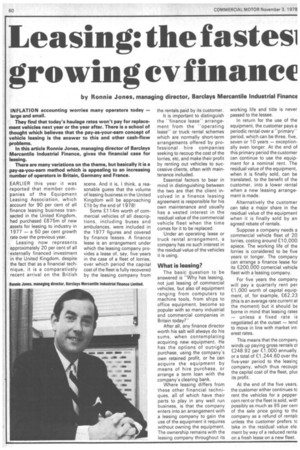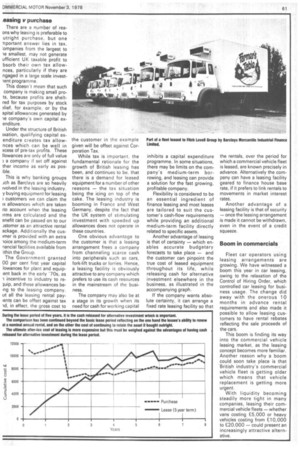Leasing: the fastesi growing ev finane€
Page 62

Page 63

If you've noticed an error in this article please click here to report it so we can fix it.
by Ronnie Jones, managing director, Barclays Mercantile Industrial Finance
EARLIER this year it was reported that member companies of the Equipment Leasing Association, which account for 90 per cent of all finance leasing business transacted in the United Kingdom, had purchased £675m of new assets for leasing to industry in 1977 — a 50 per cent growth rate over the previous year.
Leasing now represents approximately 20 per cent of all externally financed investment in the United Kingdom, despite the fact that as a financial technique, it is a comparatively recent arrival on the British scene. And it is, I think, a reasonable guess that the volume of leasing business in the United Kingdom will be approaching £1b by the end of 1978!
Some £114m worth of commercial vehicles of all descriptions, including buses and ambulances, were included in the 1977 figures and covered by finance leases. A finance lease is an arrangement under which the leasing company provides a lease of, say, five years in the case of a fleet of lorries, over which period the capital cost of the fleet is fully recovered by the leasing company from the rentals paid by its customer.
It is important to distinguish the "finance lease" arrangement from the "operating lease" or truck rental schemes which are normally short-term arrangements offered by professional hire companies seeking to recoup the cost of the lorries, etc, and make their profit by renting out vehicles to successive clients, often with maintenance included.
Essential factors to bear in mind in distinguishing between the two are that the client involved in a finance leasing agreement is responsible for his own maintenance and usually has a vested interest in the residual value of the commercial vehicle fleet when the time comes for it to be replaced.
Under an operating lease or truck rental arrangement, a company has no such interest in the residual value of the vehicles it is using.
What is leasing?
The basic question to be answered is -Why has leasing, not just leasing of commercial vehicles, but also of equipment ranging from computers to machine tools, from ships to office equipment, become so popular with so many industrial and commercial companies in Britain today?"
After all, any finance director worth his salt will always do his sums, when contemplating acquiring new equipment. He has the options of outright purchase, using the company's own retained profit, or he can acquire the equipment by means of hire purchase, or arrange a term loan with the company's clearing bank.
Where leasing differs from these other financial techniques, all of which have their parts to play in any well run business, is that the company enters into an arrangement with a leasing company to gain the use of the equipment it requires without owning the equipment. The ownership remains with the leasing company throughout its working life and title is never passed to the lessee.
In return for the use of the equipment, the customer pays a periodic rental over a "primary" period, which can be three, five, seven or 10 years — exceptionally even longer. At the end of this primary period the customer can continue to use the equipment for a nominal rent. The residual value of the equipment, when it is finally sold, can be translated, to the benefit of the customer, into a lower rental when a new leasing arrangement is made.
Alternatively the customer can take a major share in the residual value of the equipment when it is finally sold by an agreed rebate of rentals.
Suppose a company needs a commercial vehicle fleet of 20 lorries, costing around £10,000 apiece. The working life of the lorries is considered to be five years or longer. The company can arrange a finance lease for its £200,000 comercial vehicle fleet with a leasing company.
For five years the company will pay a quarterly rent per £1,000 worth of capital equipment, of, for example, £62.23 (this is an average rate current at the moment) but it should be borne in mind that leasing rates — unless a fixed rate is negotiated at the outset — tend to move in line with market interest rates.
This means that the company winds up paying gross rentals oi £248.92 per £1,000 annually, or a total of £1,244.60 over thE five-year period to the leasinc company, which thus recoupe the capital cost of the fleet, plue its profit.
At the end of the five years, the customer either continues tc rent the vehicles for a peppercorn rent or the fleet is sold, with possibly as much as 95 per ceni of the sale price going to the company as a refund of rentale unless the customer prefers tc take in the residual value element by way of a reduced renta on a fresh lease on a new fleet.
.easing v purchase
There are a number of reaons why leasing is preferable to utright purchase, but one nportant answer lies in tax. :ompanies from the largest to le smallest, may not generate ufficient UK taxable profit to bsorb their own tax allownoes, particularly if they are ngaged in a large scale investlent programme.
This doesn't mean that such company is making small prots, because profits are sheltred for tax purposes by stock for example, or by the apital allowances generated by le company's own capital exenditure.
Under the structure of British ixation, qualifying capital exenditure creates tax allownces which can be well in xcess of pre-tax profits. These Ilowances are only of full value ) a company if set off against ther income as early as posble.
This is why banking groups Jch as Barclays are so heavily 'volved in the leasing industry. y buying equipment for leasing ) customers we can claim the ix allowances which are taken Ito account when the leasing irms are calculated and the enefit can be passed on to our Jstome r as an attractive rental ackage. Additionally the cus)mer is provided with an extra loice among the medium-term hancial facilities available from ithin the Group.
The Government granted 00 per cent first year capital lowances for plant and equiplent back in the early '70s, as -1 incentive to industry to reluip, and these allowances be4ig to the leasing company. ut all the leasing rental paylents can be offset against tax -id, in effect, the gross cost to
the customer in the example given will be offset against Corporation Tax.
While tax is important, the fundamental rationale for the growth of British leasing has been, and continues to be, that there is a demand for leased equipment for a number of other reasons — the tax situation being the icing on top of the cake. The leasing industry is booming in France and West Germany, despite the fact that the UK system of stimulating investment with speeded up allowances does not operate in these countries.
One obvious advantage to the customer is that a leasing arrangement frees a company from channeling scarce cash into peripherals such as cars, fork-lift trucks or lorries. Hence, a leasing facility is obviously attractive to any company which prefers to use its cash resources in the mainstream of the business.
The company may also be at a stage in its growth when its need for cash for working capital inhibits a capital expenditure programme. In some situations, there may be limits on the company's medium-term borrowing, and leasing can provide a solution for the fast growing, profitable company.
Flexibility is considered to be an essential ingredient of finance leasing and most leases are tailored to suit the customer's cash-flow requirements while providing an additional medium-term facility directly related to specific assets.
Another advantage of leasing is that of certainty — which enables accurate budgetary forecasts to take place — and the customer can pinpoint the true cost of leased equipment throughout its life, while releasing cash for alternative investment elsewhere in the business, as illustrated in the accompanying graph.
If the company wants absolute certainty, it can arrange a fixed rate leasing facility so that the rentals, over the period for which a commercial vehicle fleet is leased, are known precisely in advance. Alternatively the company can have a leasing facility geared to finance house base rate, if it prefers to link rentals to movements in market interest rates.
Another advantage of a leasing facility is that of security — once the leasing arrangement is made it cannot be withdrawn, even in the event of a credit squeeze.
Boom in commercials
Fleet car operators using leasing arrangements are growing. We have witnessed a boom this year in car leasing, owing to the relaxation of the Control of Hiring Order, which controlled car leasing for business usage. The change did away with the onerous 10 months in advance rental requirements and also made it possible to allow leasing customers to have rental rebates reflecting the sale proceeds of the cars.
This boom is finding its way into the commercial vehicle leasing market, as the leasing concept becomes more familiar. Another reason why a boom could soon take place is that British industry's commercial vehicle fleet is getting older which means that vehicle replacement is getting more urgent.
With liquidity becoming steadily more tight in many companies, leasing their commercial vehicle fleets — whether vans costing £5,000 or heavy vehicles costing from £10,000 to £20,000 — could present an increasingly attractive alternative.




























































































































